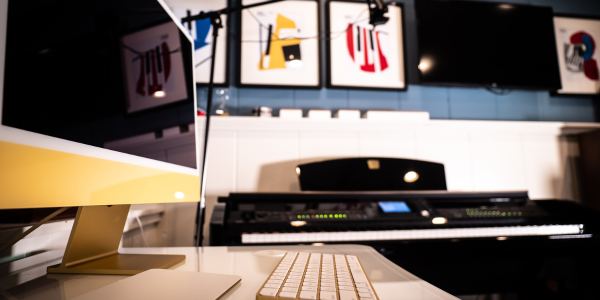We would like to thank Debra Perez, Craig Sale, Rebecca Bellelo, and Emily Book McGree for their contributions to this article on Recreational Music Making. Interested to learn more about RMM? Our latest course, A Pianist’s Guide to Teaching Recreational Music Makers, was just released. Learn more and enroll here. Use code RMMLAUNCH2024 for an exclusive $25 off.

1. Discovering Support: RMM classes are filled with students who are excited to learn and cheer on their classmates.
“RMM is not about exceptional performance—it’s about exceptional support and personal experience. RMM classes are not about the final product as much as they are about the joy found in the process along the way. Classmates encourage and support one another as they make music together. They enjoy the social aspects of learning with others. Regardless of background or age, the common thread for the students is their love of music. And they enjoy sharing this love of music with others.” – Debra Perez
2. Discovering Play: Giving students the permission to experiment and play in class leads to more curious and engaged students.
“RMM is not about teaching people to play—it’s about giving people the permission to play. Public perception about the talent required to play a musical instrument has kept people from trying. We believe that every life needs music and anyone can learn to play. The desire to play is the only prerequisite to this RMM program. [Students] are not convinced that they actually can learn to play the piano as an adult. It is important to honor the courage that is required for the adult to sign up for lessons. They simply need to be shown they can learn.” – Debra Perez
3. Discovering Balance: I needed RMM classes to balance out my other teaching commitments.
“Teaching RMM classes brought balance to my teaching life. Every hour of my usual teaching week was spent working with children to achieve higher levels of musical understanding and achievement—very intense work for both the student and me. Having a couple RMM classes during the same week, focusing on enjoying and experiencing music together, lightened my heart. Teaching in both worlds did not create a conflict in my professional life because when teaching in each of these worlds, I am meeting the needs of the student. However, they are vastly different needs. In so doing, I meet my need—my need to make music a positive force in the student’s life.” – Craig Sale
4. Discovering Repertoire: Instructors should carefully select methods and repertoire that best suit each class.
“If you are a new RMM teacher, you may wonder where to start when selecting music books or ‘methods’ to use in your classes. While no one method series is a perfect RMM curriculum, some selections are stronger candidates to use for your main curriculum based on the following:
- Are the reading, musical, and technical demands all accessible enough for my beginner RMM classes?
- How much theory or technique is included in the book?
- How are concepts presented, and what is the sequencing?
- How much review or supplemental material is available?
- Is the music exciting and engaging for home study?
- What is the cost associated with the curriculum?
- How much supplementation will I need to use?
- Does the curriculum offer more advanced materials past the beginner or primer level?”
– Rebecca Bellelo and Emily Book McGree
5. Discovering Classroom Management: It’s important to create a positive learning environment to benefit student and teacher alike.
“The true success of an RMM class relies on the instructor’s ability to manage the room. Each class you teach will have different needs and as a result, will look different from a management perspective. Ages, ability levels, personality types, and learning styles all require shifts from the instructor. Flexibility is important and an effective teacher can read the room and adjust as needed. This takes practice! Above all, I try to remember the famous Maya Angelou quote – ‘I’ve learned that people will forget what you said, people forget what you did, but people will never forget how you made them feel.’ Positive environments, where students have good relationships with the teacher and other students, are easier to manage and have positive impacts on the productivity and progress in the classroom.” – Rebecca Bellelo
Want to learn more about Recreational Music Making? Enroll in A Pianist’s Guide to Teaching Recreational Music Makers to learn more about choosing repertoire, marketing your classes, and inspiring recreational music-makers. Use code RMMLAUNCH2024 for an exclusive $25 off.
MORE ON RECREATIONAL MUSIC MAKING
- COURSE: A Pianist’s Guide to Teaching Recreational Music Makers
- MAGAZINE ARTICLE: Teaching Adults in Group-Piano Settings: Facilitating the Musical Process by Pamela Pike
- MAGAZINE ARTICLE: Take two music lessons and call me in the morning by Rebecca Grooms Johnson
- MAGAZINE ARTICLE: Where can you find training in adult teaching? by Michelle Conda, Debra Perez, Susan Ogilvy, and Jill Hannagan
- WEBINAR: Teaching the RMM Way: A Philosophy to Help Our Music Community Grow with Emily Book McGree and Rebecca Bellelo
- MAGAZINE ARTICLE: The Power of Piano Ensembles: Building Collaboration, Musicianship, and Community by Laura Silva